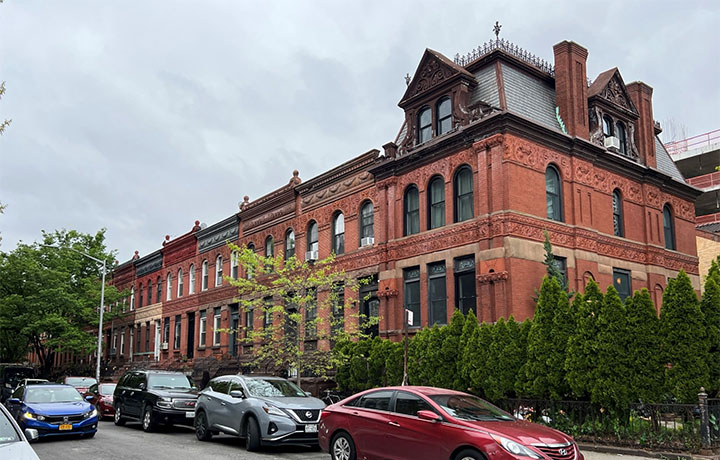
 Landmarks Preservation Commission311
Landmarks Preservation Commission311 Search all NYC.gov websites
Search all NYC.gov websites
Press Release
For Immediate Release: May 9, 2023
Contact: lpcpressoffice@lpc.nyc.gov, 212-669-7938
LPC Designates the Linden Street Historic District in Bushwick, Brooklyn
The striking collection of architecturally significant row houses stands out as an intact and distinctive example of South Bushwick's late-19th-century development that creates a harmonious streetscape.

New York – Today, the New York City Landmarks Preservation Commission (LPC) designated the Linden Street Historic District in the Bushwick neighborhood of Brooklyn. The historic district's remarkable collection of distinctive row houses, designed by Brooklyn architects, represents a highly successful integration of late-19th-century architectural styles and stands out as a cohesive and significant historic streetscape.
"New York City's history is obvious in the built environment we see around us every day, and that history should be celebrated across the five boroughs," said Deputy Mayor for Economic and Workforce Development Maria Torres-Springer. "I appreciate the work of the Landmarks Preservation Commission to celebrate our built heritage in all neighborhoods across the city and to designate Linden Street in Bushwick a historic district in recognition of its exceptional architectural and cultural significance."
"The Linden Street Historic District is the first historic district designated in Bushwick, and advances LPC's equity goals," said Landmarks Preservation Commission Chair Sarah Carroll. "The district contains some of the most strikingly artistic row houses in Brooklyn and is truly meritorious for its significant architecture, high integrity, and a strong sense of place. Today's action is very important as the agency continues to designate landmarks and historic districts in areas that are not as well represented by designations."
"The designation of Linden Street as a New York City historic district is a triumph for the Bushwick community," said Council Member Jennifer Gutiérrez. "As one of the original six Brooklyn towns, Bushwick's rich history is unfortunately often overlooked. This historic district's striking collection of architecturally significant row houses stands out as an intact and distinctive example of South Bushwick's late-19th-century development, and its preservation is a testament to our commitment to safeguarding our city's heritage. With so few landmarks remaining in Bushwick, lost to fires, gentrification, and speculation, it is all the more important that we protect and celebrate the ones that remain. I am delighted that this harmonious streetscape will be recognized as a landmark for generations to come."
"Every ornate facade and decorative window along Linden Street Historic District's row of houses tells a unique story stemming back over 125 years. All of those details are just as important to retain as the people that continue to call this neighborhood home," said Brooklyn Borough President Antonio Reynoso. "I appreciate the Landmarks Preservation Commission's support of community-driven efforts like this one to maintain history and culture."
The Linden Street Historic District is a remarkably intact group of 32 brick and brownstone row houses built between 1885 and 1901. Developed by Samuel M. Meeker and designed by Brooklyn architects in popular late-19th century styles, the row houses share common features such as continuous decorative cornices and complement each other to create a harmonious historic streetscape.
Bushwick is one of the original six Brooklyn towns, chartered in 1661 during the Dutch colonial period, and remained rural until the opening of the Broadway elevated train service at Gates Avenue in 1885 spurred speculative row house development nearby. Samuel M. Meeker owned both sides of Linden Street between Broadway and Bushwick Avenue at that time, and he and his heirs gradually developed the lots within the historic district with row houses in a picturesque variety of late-19th-century architectural styles. Built between 1885 and 1901, the row houses were designed in the neo-Grec style by Edward F. Gaylor, the Queen Anne style by Frank Keith Irving, the Renaissance Revival style by Benjamin Finksieper, and an artful combination of the Romanesque and Renaissance Revival styles by Charles E. Palmer. The ten Queen Anne-style row houses closest to Bushwick Avenue are particularly distinctive, characterized by their extensive use of decorative terra cotta, and include an impressive end house facing the avenue.
Early residents of the row houses were primarily middle- and working-class people born in New York or who immigrated from Germany, Ireland, England, Scotland, and Australia. In the mid-20th century, more Italian Americans lived on the block, reflecting the growth of this community within Bushwick's broader population and, as the neighborhood attracted new immigrants from Central and South America, the Caribbean, Asia, and the Middle East, the residents of the block have reflected these broader trends. Today this beautiful and well-maintained block continues to reflect the diversity of Bushwick and stands out within the neighborhood with its strong historic character and sense of place.
About the Landmarks Preservation Commission (LPC)
The Landmarks Preservation Commission is the mayoral agency responsible for protecting and preserving New York City's architecturally, historically, and culturally significant buildings and sites. Since its creation in 1965, LPC has granted landmark status to more than 37,890 buildings and sites, including 1,450 individual landmarks, 121 interior landmarks, 11 scenic landmarks, and 156 historic districts and extensions in all five boroughs. For more information, visit www.nyc.gov/landmarks and connect with us at www.facebook.com/NYCLandmarks and www.twitter.com/nyclandmarks.


